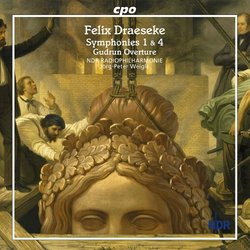| All Artists: Felix Draeseke, Jorg-Peter Weigle, NDR Philharmonic Orchestra (Hannover), NDR Orchestra Title: Draeseke: Symphonies 1 & 4; Gudrun Overture Members Wishing: 0 Total Copies: 0 Label: Cpo Records Original Release Date: 1/1/2005 Re-Release Date: 9/20/2005 Genre: Classical Styles: Opera & Classical Vocal, Symphonies Number of Discs: 1 SwapaCD Credits: 1 UPC: 761203974627 |
Search - Felix Draeseke, Jorg-Peter Weigle, NDR Philharmonic Orchestra (Hannover) :: Draeseke: Symphonies 1 & 4; Gudrun Overture
 | Felix Draeseke, Jorg-Peter Weigle, NDR Philharmonic Orchestra (Hannover) Draeseke: Symphonies 1 & 4; Gudrun Overture Genre: Classical |
Larger Image |
CD Details |
CD ReviewsCPO Draeseke cycle now complete A K Howe | Clacton-on-Sea, England | 12/08/2005 (5 out of 5 stars) "The issue of this CD marks the end of Jörg-Peter Weigle's cpo cycle of the symphonies by Felix Draeseke (1835-1913). And, all in all, it has proved a triumph, for Weigle and his pioneering German recording company cpo have now proved what a small number of experts and enthusiasts have long suspected: that Draeseke is the most important neglected nineteenth-century symphonist, and a composer of a stature equal with that of Brahms (who regarded him as his keenest rival)and Bruckner. Draeseke's greatest symphony is undoubtedly his third, the 'Tragica', completed in 1886. Indeed, it is worthy to be ranked with the greatest symphonic creations of its time. The CD under consideration here, however, presents us with the first and last of his symphonies, dating respectively from 1868-72 and 1912. So what are they like, and how do they rank within the overall symphonic canon? Symphony No.1, it must be remembered, predates the symphonies of Brahms and all those of Bruckner from No.3. When heard in its historical context, therefore, it emerges as a quite extraordinary achievement - at least the equal in quality of, say, Bruckner's second symphony. Furthermore, its slow movement is quite possibly the greatest of its kind between that of Schumann's second and Bruckner's seventh. In trying to characterise the music, one thing is very obvious: this is emphatically not music of the conservative stamp of Brahms. Indeed, although still attached to the classical forms (symphony, concerto, etc.), Draeseke poured into them music which was clearly influenced by the New German School of Wagner and Liszt. Thus there is a harmonic daring, richness and even astringency which is quite different from the procedures of Brahms. In fact, when one has listened extensively to Draeseke, one simply recognises a new, original voice - and one which has been scandalously neglected and, when heard, misunderstood. The fourth symphony, the 'Comica' is a late work - the master production of a master composer in his final year. It is almost an ironic signing-off of a tradition which was fading, as newer compositional currents (Richard Strauss, Max Reger, etc.) were coming to the fore. It is not a great work, but it is the work of a great composer - and how that composer had moved on harmonically over the course of his long life! Finally, the CD also contains the overture to Draeseke's opera 'Gudrun'. This proves a wise choice on cpo's part because if ever a piece were designed to show off Draeseke's abilities, this is it. It has mystery, drama, power and a superb command of the orchestra. Music-lovers everywhere should snap up this wonderful new recording while they can. And then they should investigate the other two CDs in the cpo cycle. Sell your shirt and buy the complete cycle: you will then be in possession of a symphonic cycle to rival the greatest of the nineteenth century!" E for Effort J Scott Morrison | Middlebury VT, USA | 10/03/2005 (3 out of 5 stars) "Among the also-rans of the late 19th century was Felix Draeseke (1835-1913). He began as an acolyte of Wagner, wound up moving more towards the Brahmsian camp. His First Symphony retains fingerprints of both those composers, but one can clearly hear him moving more towards the classicist approach of Brahms. Aside from the retention of some pretty hair-raising Wagnerish modulations, the style of the symphony is certainly Brahmsian. The First Symphony, although not Draeseke's first effort at a symphony, has more than its share of awkwardness. The first movement makes use of seemingly unending sequences, strange voice-leading, idiosyncratic harmonies. It and its subsequent movements are also marked by uninspired melody writing. The almost elfin Scherzo is the most winning of the four movements and in its day even had a life as a stand-alone piece, being published on its own. Although there is some beautiful playing, the slight tentativeness of the NDR Symphony in this symphony does not help the work make its case.
The 1912 Fourth Symphony (written when Draeseke was seventy-seven) is subtitled 'Symphony Comica' for reasons that escape me; it is presumably a counterbalance to the Third Symphony, the 'Symphonia Tragica' of 1886. The comedy here is lumpish at best; perhaps it's simply Teutonic humor, and indeed there are some echoes of 'Meistersinger' in its counterpoint at the service of good humor. But it misses the mark by rather a large margin. Again, there is a paucity of memorable melodic material, but the working-out is a good deal more seamless than in the first symphony. The NDR Symphony, under Jörg-Peter Weigle, seem more at home here, and they do their best to put the work in the best light, but frankly it comes nowhere near being in the same class as such near-contemporary works as Mahler's symphonies or Strauss's tone poems. The filler work is the 11-minute 'Gudrun Overture.' It is of a piece with the symphonies and not particularly memorable. Both symphonies were nice to hear a few times, but I suspect I will not feel the need to hear either again. Scott Morrison" |
